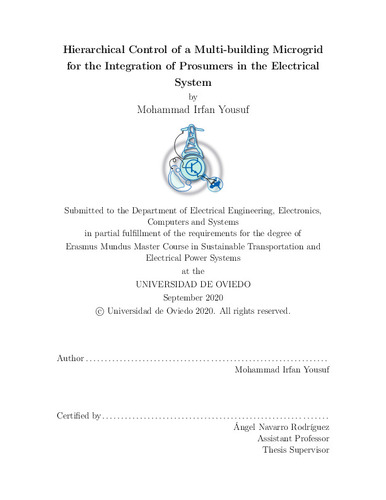Hierarchical Control of a Multi-building Microgrid for the Integration of Prosumers in the Electrical System
Author:
Director:
Subject:
Hierarchical Control of a Multi-building Microgrid for the Integration of Prosumers in the Electrical System
Publication date:
Serie:
Máster Universitario Erasmus Mundus en Transporte Sostenible y Sistemas Eléctricos de Potencia
Abstract:
The hierarchical control structure of a multi-building microgrid usually contains four levels. Inner control of the converter, primary droop control, secondary control to eliminate the steady state error inherent from the primary control and tertiary control to exchange power from the microgrid to the grid and vice-versa. Advanced control strategies are essential components for understanding the microgrids to provide control over the production of power from renewable sources. This thesis reviews the status of the hierarchical control strategies applied to microgrids, proposes a control structure based on the existing methods for a case study consisting in a multi-building microgrid and discusses the future trends. Different droop control structure based on voltage levels is studied. An improved secondary control to compensate the communication delay and improve microgrid stability has been proposed in this thesis with Smith Predictor. Communication channel is modelled using Poisson distribution and impact of variable communication delay on the microgrid is also briefly studied. Tertiary control which is generally more related to economic optimization based on electricity market and energy prices has been modelled and simulated to allow the microgrid act as a single entity which can receive active and reactive power commands from the (DSO) as a dispatchable PQ node. Additionally, the coordination among different control levels is reviewed.
The hierarchical control structure of a multi-building microgrid usually contains four levels. Inner control of the converter, primary droop control, secondary control to eliminate the steady state error inherent from the primary control and tertiary control to exchange power from the microgrid to the grid and vice-versa. Advanced control strategies are essential components for understanding the microgrids to provide control over the production of power from renewable sources. This thesis reviews the status of the hierarchical control strategies applied to microgrids, proposes a control structure based on the existing methods for a case study consisting in a multi-building microgrid and discusses the future trends. Different droop control structure based on voltage levels is studied. An improved secondary control to compensate the communication delay and improve microgrid stability has been proposed in this thesis with Smith Predictor. Communication channel is modelled using Poisson distribution and impact of variable communication delay on the microgrid is also briefly studied. Tertiary control which is generally more related to economic optimization based on electricity market and energy prices has been modelled and simulated to allow the microgrid act as a single entity which can receive active and reactive power commands from the (DSO) as a dispatchable PQ node. Additionally, the coordination among different control levels is reviewed.
Collections
- Trabajos Fin de Máster [5247]
Files in this item





